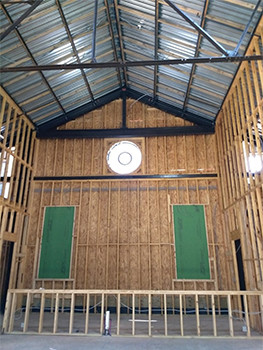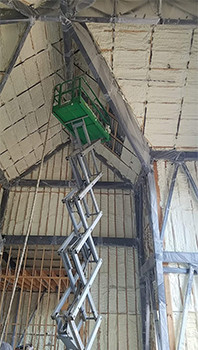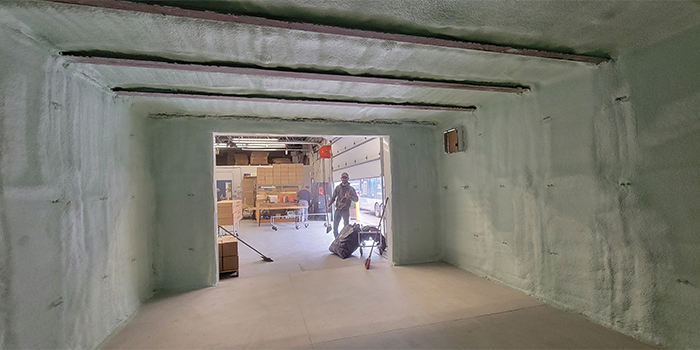Magnificent Manor


Spray Foam Magazine – Fall Issue 2021 – Texas Foam Insulators is based in Willis, TX and they have such a grand reputation, they even have builders out of state that will only use them and insist on paying for the crew’s travel fees. Texas Foam Insulators is owned by Aubrey Hall, but the day-to-day running of the business is handled by general manager Mike Ladyman. Lead sprayer Stephan Cummings describes Ladyman as, “One of the best employers I have ever worked with. He definitely deserves credit for the company running so smoothly.”
The Texas Foam Insulators crew was the obvious choice when it came to insulating a unique venue in Montgomery, TX—Iron Manor. The manor was originally constructed in 1903 for the Pure Oil Company and was at that time called Crane Hall. The columns within the building were from the Carnegie Steel Co. with each one being part of the American industrial revolution history.
In 2015, the inner structure of Crane Hall was carefully removed from the West bank of the Dam Jacinto River in Montgomery County. The now Iron Manor was built three years later in July 2018, also situated in Montgomery. The architect’s main vision was to build the 17,000 sq. ft. structure to include the original riveted steel and many of the original bricks from Crane Hall. The restoration process took two and a half years and with the input of the architects, industrial artists, technicians, and contractors this vision became an incredible reality.
Lead sprayer Cummings has been spraying for 12 years, and he has been at Texas Insulators for four years. In addition to spraying, he focuses on training new sprayers, sales, fixing rigs and keeping everyone happy and working. He told Spray Foam Magazine why the architects had asked for foam to be installed, “Well why wouldn’t they? Foam really is the best. Foam stays where it is sprayed, and it never settles, while remaining airtight for the life of the building. Not to mention fiberglass is way too difficult to get into all the little holes, meaning lots of places for hot air to enter unimpeded causing major issues down the line. Foam creates an airtight envelope around the entire building. Which means you keep every penny of bought air.”
The crew working with Cummings on the Iron Manor job included Shane Weekly as the second sprayer and Betuel Sanchez as the lead helper. They arrived on site with their equipment, which consisted of a Graco E-20 reactor, a Fusion AP gun with a 5252 mixing chamber and lots of plastic wrap. The crew worked at the Iron Manor for two weeks and for the first few days, they prepped and wrapped everything in plastic trim including all the iron and steel, floors, doors, and windows. Then they cleaned surfaces using a multi-purpose cleaner to remove grease and debris from all the welding and other construction. The steel beams salvaged from the demolished building were going to be exposed so the crew had to make sure the plastic stayed in place. However, other contractors needing to do their jobs would sometimes need to remove plastic and rarely put it back. The crew had to be very vigilant about this and make sure the plastic was replaced.
The substrate was an assortment of Oriented strand board (OSB), a metal sheeting roof, cinderblock walls and steel. Cummings and his crew applied both Carlisle’s Open-Cell OCX and their Closed-cell SealTite Pro for their fire rating, even though all the foam was being covered.
When the Texas Foam Insulators usually spray, they don’t work around other contractors for obvious safety reasons. However, this job was a big enough area that the crew were able to spray sections at a time coordinating with the other contractors on site. They had areas marked so other contractors knew not to enter. There was also plenty of ventilation and fans pushing air like a cyclone, keeping the vapors away from other contractors, which caused its own set of issues, but it was necessary to keep everyone safe.


The Iron Manor is split in 4 spaces – the Crane Hall which can fit 350 guests, the Iron Chapel for wedding ceremonies, the Bridal suite and the Groom's Room. In total, the crew sprayed over 14 sets of foam to complete the installation to the 17,000 sq. ft. structure.
The crew sprayed three and a half inches of open-cell in the walls, six inches open-cell in the roof and two inches of closed-cell on the cinderblock walls around the building’s towers, plus three inches of closed-cell sprayed around a cooler. In total the crew sprayed an impressive 13 sets of open-cell and one and a half sets of closed-cell foam. Cummings recalls, “Instead of starting at one side and working to the other, we had to leave certain areas unsprayed so other trades could finish their work. The building was so big, I had to move my rig a few times, spraying a section at a time. The floors had to stay covered because other contractors were dragging their stuff around which pulled it up. Naturally, when working on such a large project around so many other contractors, things are going to happen. We just did our due diligence to make sure things were done right. One of the highlights was our ability to show the framers where to build a few hot walls for our envelope.”
Overall, the crew were very happy at how smoothly the job went. “The other trades were fascinated watching us spray, and every time I turned around, someone had their camera out,” laughed Cummings. He closed the interview by stating, “I’ve had to work around a lot of other contractors in my time, it’s always a worry because not everyone works with respect for other trades, but this project definitely had harmony with everyone.”
Like the magnificent Iron Manor, if the bones of the building, or project, are solid, then everything else falls into place.
Disqus website name not provided.









































